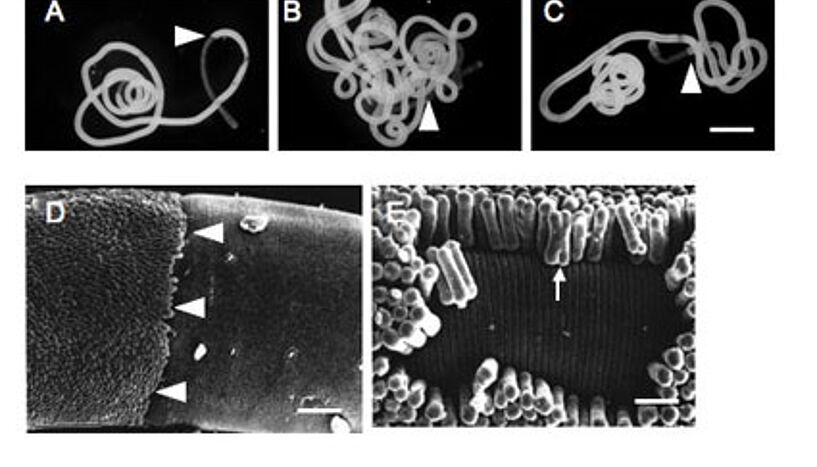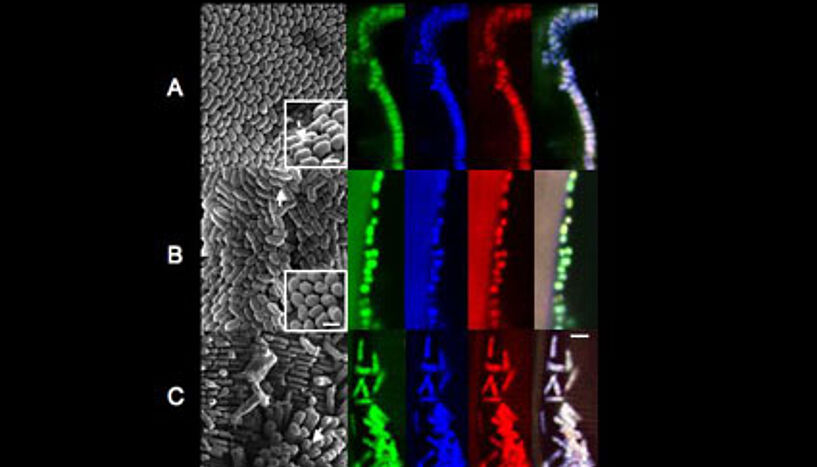An inseparable marine couple
| 21. Oktober 2010Silvia Bulgheresi from the Department of Genetics in Ecology considers the marine nematode Laxus oneistus her favourite worm. To find it in nature, she travels to Belize in Central America. In the shallow water of the Caribbean Sea, this stilbonematid nematode lives in symbiosis with bacteria located on its cuticle. Unlike other animals or human beings who carry many different microbes, the worm has a beneficial association with only one species of bacteria.
"This symbiosis is in many ways exceptional", Bulgheresi starts her account of a fascinating fact: "Apart from a tiny shrimp that was found in a cave in Italy, stilbonematid worms - a small family of marine nematodes - are the only animals that carry only one kind of microbe on its surface." Taking into account that animals, including humans, are usually associated with a high number of different microbes, this special "living community" is a matter of particular interest for the scientist who has been dedicating several years of research into Laxus oneistus.
In the three-year project "Ectosymbioses of Marine Nematodes" the scholar and her team wish to discover the genes that play a crucial role in the symbiosis. They'll investigate those genes that are specifically expressed in glands underneath the worms' cuticle. These glands produce a mucus layer in which the symbionts are embedded. Results of past research projects have shown that this mucus contains Mermaid, a protein that attaches the bacterial symbionts to the worm. As a consequence of this close connection between nematode and bacteria, even the process of cell division differs from other bacteria not living in symbiosis.
The worm's home: The Meso-American Barrier Reef
But let's go back and start from the beginning. Equipped with a bucket, a plastic flask and a sieve, Silvia Bulgheresi and her team leave for the beach in the early morning. They are located on a marine field station on the island Carry Bow Cay belonging to Belize in the Meso-American Barrier Reef, the second largest reef after the Great Barrier Reef in Australia: "It's the perfect place to find those animals. The process is easy; we simply take a mixture of sand and seawater, shake it as hard as we can to extract the worms from the sand and filter the worm enriched seawater through a sieve."
What remains is the worm, measuring up to one centimeter. Even though it's quite a size, the thin nematode is hard to spot in the sand. The researcher explains how the work continues: "As the field station only offers basic equipment, we have to deep-freeze them in order to make experiments on the molecular level later on in Vienna. So what we do in Belize, once or twice a year, is mainly collecting the animals to get them back to Austria."
Symbiosis in white
Safely transported from Belize to Austria, the work on the nematodes continues in the lab. It all started with the worm's appearance: Laxus oneistus is bright white. Baffled in the first place, a group of scientists around Bulgheresis mentor, Jörg A. Ott, soon found out that bacteria of the class Gammaproteobacteria are causing this. The nematode lives in a symbiosis with sulfur-oxidizing bacteria which are capable of storing elemental sulfur, hence the white exterior. This is also the key to this particular symbiosis: Sand is only rich in oxygen on the surface. The deeper you go, the oxygen fades and sulfide predominates. What the bacteria need as a source of energy is both sulfide and oxygen. As the worm migrates between superficial and deeper layers of sand, the bacteria are perfectly provided with those two elements. The question remains as to how the nematodes benefit from this association. "If you cut a nematode open, you'll find the same bacteria as on its outside. That forms the conclusion that the worm eats the bacteria", Bulgheresi summarises.
Detecting genes
Knowing about the symbiosis and some of its advantages for both nematodes and bacteria raises a handful of further questions. First of all the scientists look into the worm’s DNA. Genes instruct the production of proteins and are therefore directly involved in the symbiosis. "Experiments in separating the bacteria from the worm led us to Mermaid, a mannose-binding protein which obviously aggregates the bacteria. This protein is an important component of the mucus. What we are now aiming for is to find other genes that are involved in symbiont attachment to the worms' surface or in the repulsion of unwanted microbes", Bulgheresi explains the upcoming tasks.
Further research will be done into another remarkable observation, the "longitudinal fission". Only bacterial rods living in symbiosis undergo cell division lengthwise instead of transversal. "If they divided in the 'usual' way, they would lose contact with the nematode. Symbionts of other stilbonematid nematodes don't divide at all; they simply get longer and longer. It is such an interesting phenomenon to investigate", the scholar shares her enthusiasm for the subject. (dh)
Dr. Silvia Bulgheresi works at the Department of Genetics in Ecology. The project "Ectosymbioses of Marine Nematodes" started in June 2010 and ends in July 2013. The PhD student Niels Robert Heindl as well as the three prospective undergraduate students Amir Schmidt, Lisa Bauer and Nika Pende are participating in the project.




